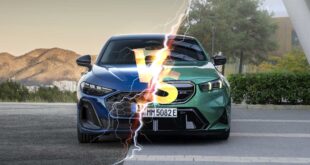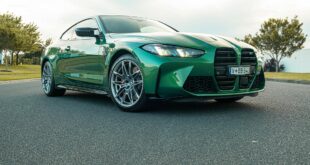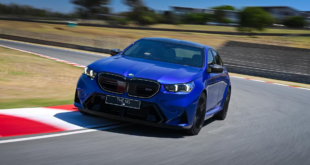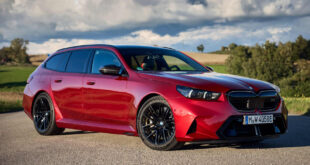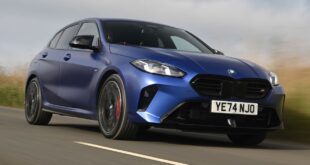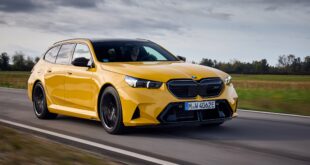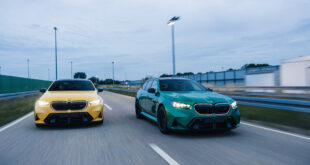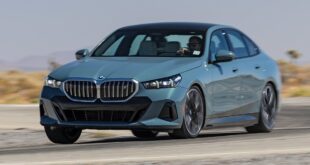 “A company is like a human being. As long as it goes in for sports, it is fit, well-trained, full of enthusiasm and performance.†These were the words of Robert A. Lutz, BMW AG Board Member Sales, back in 1972. They were the words christening the youngest subsidiary of BMW AG at the time, BMW Motorsport GmbH. Today the company is called BMW M GmbH. But it is just as fit, well-trained, full of enthusiasm and performance as it was 40 years ago.
“A company is like a human being. As long as it goes in for sports, it is fit, well-trained, full of enthusiasm and performance.†These were the words of Robert A. Lutz, BMW AG Board Member Sales, back in 1972. They were the words christening the youngest subsidiary of BMW AG at the time, BMW Motorsport GmbH. Today the company is called BMW M GmbH. But it is just as fit, well-trained, full of enthusiasm and performance as it was 40 years ago.
The early 1970s were the dawn of a new age for BMW: A new, young Board of Management under Eberhard von Kuenheim had set out to strategically power and pursue the ongoing success of the Company. This included the construction of a new head office – the legendary BMW Four-Cylinder – as well as the establishment of BMW’s own in-house Sports Division. Quoting Robert A. Lutz once again: “With sports always being a driving force at BMW, also while the Company was developing dynamically in the business world, it was only obvious at this point that we should concentrate and consolidate our activities in motor sport.â€
Indeed, demand and untapped opportunities exceeded the potentials and capacities of the former Sports Department by far. The BMW 1800 TI and 2000 TI, as well as the entire 02 Series, were the most popular competition cars winning one race after the other. But BMW itself was able to meet only a fragment of the overall demand, the vast majority of cars being prepared, run and sold by tuning companies. Since the mid-1960s, BMW had also been involved in Formula 2 – and in the years to come hardly a team anywhere was able to enter this Formula successfully without BMW’s high-performance power units. Countless racing wins and European Championships by BMW dominated the scene.
1972: A team highly experienced in racing forms BMW Motorsport GmbH.
BMW Motorsport GmbH, facing the challenges described, took over on 1 May 1972. The Managing Director of this team of specialists originally made up of 35 employees was Jochen Neerpasch, an ex-Porsche works driver and Ford’s Racing Manager in Cologne before moving to Munich.
He immediately attracted a whole group of racing drivers destined to leave their stamp on BMW Motorsport for decades to come: Chris Amon, Toine Hezemans, Hans-Joachim Stuck and Dieter Quester. Björn Waldegaard and Achim Warmbold were hired by the Company as rally drivers.
The new company was able to move into its own building after just a few months, with the racing workshop and racing engine production shop, toolmaking and the engine dynamometer all being installed in the immediate vicinity of BMW’s Munich Plant on a site measuring more than 8,000 square metres in Preussenstrasse. This is where the sports machines for 1973 saw the light of day: A 950-kilo 2002 powered by a two-litre four-valve four-cylinder for rally racing, with maximum output of 240 hp, as well as a new touring coupé described by Jochen Neerpasch in the early days in very clear words: “Since we saw 1973 as our kick-off year, we didn’t expect to win this European Championship right away.†The model designation of the new car was 3.0 CSL. The doors and lids were made of aluminium, the five-speed gearbox featured a magnesium housing. Overall weight was 1,092 kg or 2,408 lb. But the real highlight was hidden beneath the hood, a 3,340 cc straight-six with 12 valves, fuel injection and a compression ratio of 11:1. Maximum output: 360 hp. This was the last two-valve engine that BMW built for racing.
BMW’s traditional philosophy: The human focus.
BMW Motorsport GmbH entered the 1973 season perfectly prepared not only in technical terms. The drivers were also top-fit, with Jochen Neerpasch taking the entire team of drivers to a “driver tuning†season in St. Moritz. Here, in this Swiss skiers’ paradise, the entire team received the final touch from a sports instructor and a sports psychologist. Even back then, in the very early years, BMW attached the utmost importance to optimisation of the man/machine interface. And there were even plans back then for similar courses to be offered to “non-professionalsâ€. Since 1977 these courses have been called BMW Driver Training.
This was the team BMW Motorsport GmbH took to the race track in the 1973 season. And it was not only the 3.0 CSL coupé that hit the headlines from the very beginning: For the first time a complete racing team from the car transport vehicle to the key tag came in the same design.
These were the three blue, violet and red colour stripes on a brilliant white background characterising the look of BMW Motorsport to this very day.
The CSL coupés in these colours soon known to everybody in the world of motor racing were unbeatable. Hans-Joachim Stuck and Chris Amon brought home the Touring Car Grand Prix at the Nürburgring in their very first attempt. BMW was the overall winner of the Touring Car Category in the 24 Hour Race at Le Mans.
The most successful touring car of its day: The BMW 3.0 CSL .
The 3.0 CSL dream coupé in its spectacular racing livery subsequently became the most successful touring car of its time, winning the European Championship six times between 1973 and 1979 and dominating the international touring car scene for almost a decade. But the BMW 3.0 CSL was a pioneer not only in its colour design, but also through a whole range of significant technical innovations: First, it was powered from 1973 by BMW’s first-ever four-valve six-cylinder. Second, it featured a prototype anti-lock braking system from 1974, long before this innovation became standard technology in the BMW 7 Series. And at the end of its career, in the guise of the turbo coupé, the 3.0 CSL developed maximum output of up to 800 hp. In 1976, BMW Motorsport GmbH sent BMW’s most powerful touring car out on to the track with Ronnie Peterson at the wheel, this supreme version of the CSL featuring a 3.2-litre biturbo engine with output intentionally reduced to 750 hp.
BMW Motorsport GmbH maintained its successful process of development also in Formula 2: Fifty of BMW’s two-litre four-valve engines went to March, subsequently winning 11 out of 16 races. In 1973 Jean Pierre Jarier, powered by a BMW engine, brought home the European Formula 2 Championship at the wheel of his March and the engine dominated the two-litre category consistently for nearly ten years, with Patrick Depailler (1974), Bruno Giacomelli (1978), Marc Surer (1979) and Corrado Fabi (1982) winning the European title in their BMW-powered March Formula 2 racing cars. Other teams were equally thrilled by this two-litre four-cylinder built in a production run of more than 500 units, most of which developing over 300 hp.
In 1975, BMW Motorsport GmbH shifted its focus to the other side of the Atlantic: Now the Company concentrated on the US IMSA Series, seeking in the process to present the letters “BMW†to a larger US market. When the year came to an end, the number of US citizens who knew that BMW stood for “Bavarian Motor Works†had increased considerably – and this was no surprise with BMW winning the Manufacturer’s Category in the IMSA Championship.
1976: The “driver’s school†becomes BMW Driver Training.
On 3 February 1976, BMW’s Board of Management decided to entrust BMW Motorsport GmbH with yet another task: to professionalise an activity still referred to at the time as a “driver’s schoolâ€. The original brief given to the Management of the Company was to organise 15 courses a year with 20 participants each at BMW’s test facilities, as well as five additional courses with 100 participants in each case on race tracks – that is a total of 800 participants a year. “As the Company responsible throughout BMW for all motor sport activities, BMW Motorsport GmbH wishes to promote the driver in his performance as part of the man/machine system.†This was the key statement in the initial publication of BMW Driver Training – and it remains valid to this very day.
From the very beginning one of the main features of BMW Driver Training was to provide the cars for the participants to use – and this philosophy remains unchanged to this very day. This means that all participants have the same cars in technical terms and need not worry about tyre wear and their own cars. To implement this philosophy in practice, the Company established its own small fleet of BMW 320i’s, at the time the ideal car for training with its maximum output of 125 hp. All of these cars featured a specially tuned suspension, a limited-slip differential with 40 per cent locking action, and a bucket seat for the driver. So BMW’s first “team†in Driver Training was certainly well prepared.
The BMW Driver Training curriculum was all set and ready to go following the first test courses at the Manching Military Airfield near Ingolstadt, Rauno Aaltonen officially signing up as BMW’s first chief instructor on 13 January 1977. In fact, Aaltonen applied his experience not only on the track, but also through the only book on driver training published at the time: “Revolution at the Wheel†– a unique book clearly describing the course and its curriculum, and therefore sold out almost overnight. To this very day, the “Flying Finn†passes on his unique skills to BMW drivers, although the focus has now for a long time been on greater safety.
Soon making their appearance: The first “extra-hot†road-going BMW.
Well into the second half of the 1970s, BMW Motorsport GmbH focused almost exclusively on the construction of racing cars. The new BMW 320 entered in Group 5, for example, continued the outstanding success of the 02 Series. But many a good customer – not just racing drivers, but also BMW enthusiasts in everyday life – were also looking for M Power on regular roads and this is how the first “hot†5 Series came into being from 1974: the 530, 533i, 535i. Indeed, these cars were superior to their production counterparts not only in terms of their engines, but also in their suspension and brake technology receiving the special attention of the engineers at BMW Motorsport GmbH. “Regular†saloons almost “normal†at first sight thus became the first high-performance four-seaters revolutionising the world of the sports car through their sophisticated technology. Initially these were built and sold only in very small numbers, but soon the performance philosophy became increasingly popular. By 1980, 895 units based on the first 5 Series had been purchased.
The big sensation in the world of sports cars in 1978: The BMW M1.
The next project to come along was geared towards producing Motorsport GmbH’s first competition car not based on a regular production model: the BMW M1. While BMW built the technical components, Lamborghini was supposed to supply the body and the chassis. However, financial problems at Lamborghini resulted in significant delays. Ultimately, a new production chain had to be found and the manufacture of the BMW M1 turned into something of a patchwork puzzle. The spaceframe was manufactured at Marchesi, the glass-fibre reinforced plastic bodyshell was produced at T.I.R., both companies were based in Modena. Giorgio Giugiaro’s company ItalDesign assembled them and provided the interiors fittings. The cars were then transported to Stuttgart where Baur installed all the mechanical assemblies.
Jochen Neerpasch, the Managing Director of Motorsport GmbH, joined forces with Bernie Ecclestone and Max Mosley to create the ProCar Series as the opening race leading into most European Formula 1 Grand Prix during the 1979/80 season.
Since the minimum production requirement for homologation in FIA Group 4 was 400 units, the ultra-low mid-engined M1 measuring a mere 1.14 metres in height also came as a road-going model. The first car with the famous letter “M†made its debut in the market. The price of the 277 hp M1 back in 1978 was exactly DM 100,000, but demand exceeded supply by far. When 130 cars had been completed after one year, there were still more than 300 firm orders waiting to be fulfilled. Right from the start the M1 was the fastest road-going sports car built in Germany, as timed by a leading car journal: In a test conducted in 1979, the M1 reached a top speed of 264.7 km/h or 164.1 mph. “You only have to shift up from fourth to fifth at 213 km/h or 132 mph, and then keep on accelerating all-out up to the top speed of the car,†according to the testers. Lots of customers appreciated this, as did the subsequent Formula 1 World Champion Alan Jones.
Even this was very little compared with the racing version: Developing 470 hp, the ProCar racing version had a top speed well over 300 km/h or 190 mph. And it was in one of these cars that Niki Lauda, already two-time winner of the Formula 1 World Championship, made his big appearance in 1979, winning three out of 8 M1 ProCar races and finishing second on another occasion. In the USA the Red Lobster Team Ml’s quickly became genuine cult cars wiping out the competition in the IMSA GTO Class.
Motivated by the outstanding success of the M1 and its great image, Motorsport GmbH decided to build another model: Proceeding from the regular 5 Series, the engineers developed and built the M535i in 1980, carrying over the two-valve six-cylinder from the 635CSi. With engine output of 218 hp, this 5 Series quickly became the king of the fast lane.
Formula 1 sensation in 1980: BMW creates the World Championship turbo engine.
Jochen Neerpasch left Motorsport GmbH in 1980 and was succeeded by Dieter Stappert taking over as the Racing Director. Paul Rosche, in turn, who had been responsible for BMW racing engines since 1969, was appointed Technical Director. And it was indeed Paul Rosche who became the key player when BMW decided in the early 1980s to prove its competence also in the highest realms of motor sport: In April 1980, BMW officially announced its entry into Formula 1, giving the engineers at Motorsport GmbH the green light to develop BMW’s first Formula 1 power unit:
Taking a four-cylinder displacing only 1.5 litres and based on a standard production block, the team of specialists around engine “wizard†Paul Rosche created a Formula 1 power unit developing staggering output of 800 hp. The secret behind this mind-boggling performance was the combination of 16-valve technology and a turbocharger masterminded for the first time in Formula 1 by Digital Motor Electronics.
The first training car was put through its paces in practice just a year later and in 1982 Brabham entered the first Grand Prix with a BMW engine. Right from the start, this turbocharged power unit proved its supremacy on the track, with the greatest triumph following in 1983: Just 630 days after BMW’s Formula 1 engine had made its first appearance, Brazilian driver Nelson Piquet won the World Championship in a Brabham BMW. And up to 1987 BMW brought home a total 9 Grand Prix wins with this successful machine.
BMW M turbo engines did not only go to the Brabham Team. Arrows also used the M power machine from 1984 to 1986, just like ATS in 1983/84 and Ligier in 1987. In 1986, Gerhard Berger won the race in Mexico in a Benetton car, marking the last triumph of this turbocharged power unit. A year later Road and Track, the US car journal, demonstrated the supreme performance of the Benetton B 186 with Teo Fabi at the wheel: Powered by 900 hp, Fabi’s monoposto accelerated to 100 mph (160 km/h) in exactly 4.8 seconds. And Paul Rosche was confident that this four-cylinder was able to develop a lot more power in practice: “It must have been about 1,400 hp, but we don’t know the exact figure since the engine dynamometer didn’t go beyond 1280 hp.â€
Another important event in 1983 went almost unnoticed: BMW Motorsport GmbH took on additional functions and responsibilities when it was transformed into a performance-oriented development company. Accordingly, the headcount at BMW’s highly successful subsidiary was now increased to 380, further important responsibilities such as motor-sport organisation, administration and workshops being added to the development, design and testing of outstanding BMW products. This saw the creation of individual development centres for engines and suspension technology providing the input for these activities. And in its customer relations Motorsport GmbH had already been offering far more than “just†sophisticated automotive technology for a long time already, sales of accessories and the growing wish of discerning customers for custom-built and individually equipped cars already accounting for a significant share in sales.
BMW M1 six-cylinder also featured in production cars: The M5 and M635CSi.
In 1984, Motorsport GmbH hit the headlines once again, especially among all aficionados of high-performance sports cars: The fast-revving four-valve straight-six originally featured in the M1 now made its appearance in the M635CSi Coupé and in the M5. Particularly the M5 hand-built in Preussenstrasse quickly became a legend in the world of motoring: The M5 was a genuine “wolf in sheep’s clothingâ€, with output of 286 hp exceeding the engine power of the 518i almost three times. While at first sight the M5 could hardly be distinguished from its regular production counterpart, its top speed of 245 km/h or 152 mph caught many drivers of big saloons and sports cars thoroughly by surprise when the M5 simply left them standing no matter how hard they tried. The term “Executive Express†was born.
1986: The debut of the M3, the most successful touring car ever.
After completing its activities in Formula 1, Motorsport GmbH focused all its energy on touring car racing. And in 1986 this resulted in the birth of the BMW M3, a compact two-door sports saloon representing BMW’s first parallel development in series production and motor sport: The road version requiring a production run of 5,000 units within one year for recognition as a touring car was conceived for racing right from the start and tailored in virtually every respect to the regulations in Group A. Since the facilities in Preussenstrasse were unable to handle the sheer magnitude of the tasks involved, Motorsport GmbH moved to its second home in the Munich suburb of Garching in 1986.
The result was an outstanding success for BMW in every respect. Right from the start, this brilliant white racing car in BMW Motorsport livery brought home one racing win, trophy and title after the other: In 1987, Italian driver Roberto Ravaglia won the World Touring Car Championship at the wheel of a BMW M3.
Developing maximum output of 195 hp from its four-cylinder 16-valve power unit and featuring a catalytic converter as standard, this high-performance saloon became the benchmark in motor sport from now on.
In the five years to follow, the M3 was the uncontested leader in the international touring car scene, bringing home two European Touring Car Championships, winning the German Touring Car Championship (DTM) twice as well as a large number of other international events and championships, and thus becoming the most successful touring car.
The M3 was equally successful as a road-going car for customers, reaching a sales volume nobody would have expected: Sales of the first BMW M3 amounted to more than 17,970 units, including 600 2.5-litre M3 Sportevolution models as well as 765 M3 convertibles built by hand. The M3 also proved that sporting performance and environmental protection need not necessarily be a contradiction in terms, with the M3 offering a standard of fuel economy quite unparalleled in relation to its power and performance.
A new market: The second M5 also built as a touring car.
The M5 entered its second generation in 1988, the straight-six power unit originally displacing 3.6 and subsequently 3.8 litres, with output increasing first to 315 and then to 340 hp. Another change was that the engines no longer bore the “M†in their internal production code, but rather an “S†designating the origin of BMW Motorsport GmbH power units from now on. The customer is able to determine the difference at a glance, the letters “BMW†now being replaced by “M Power†on the valve cover, just as on the M3 four-cylinder. The M5 was initially introduced as a saloon and then at the beginning of 1992 as a touring to create Âa unique synthesis of a thoroughbred sports car and a sophisticated transport vehicle.
When the next 3 Series was set to make its appearance in 1990, Motorsport GmbH was already working on the new BMW M3 which was launched on the market in 1992. But the new car was no longer adorned by striking spoilers and widely flared wheel arches, like its predecessor. Instead, the new M3 – reflecting the signs of the times – came in a more discreet look and was recognisable to the connoisseur only through specific details – one of which, of course, being the unmistakable sound generated by the three-litre six-cylinder four-valve power unit developing maximum output of 286 hp. This M3 six-cylinder was also BMW’s first engine with VANOS variable valve timing, an infinitely adjustable system varying the intake camshaft as required. This system patented by BMW M boosts torque above all at low and medium engine speeds.
Another unique feature on this car seen for the first time was the introduction of engine management developed by BMW and with a capacity of 20 million instructions per second.
The Car of the Century: The second BMW M3.
Customers and the media alike simply loved this M3 right from the start. The order books were full immediately and the first titles and awards were just around the corner. The readers of sport auto, the German motor magazine, made this most agile of all BMW 3 Series their “Car of the Year†no less than twice in a row, Auto Plus in France even chose the M3 following a comparison with other upmarket models as the “Car of the Centuryâ€. And immediately after the M3 had been launched in the USA, the editors of Automobile Magazine gave the new star their “Car of the Year†award, the first time ever that this prize went to an import.
This time both a convertible and a somewhat more comfort-oriented saloon were included in the planning process right from the outset. Developing maximum output of 295 hp, the M3 GT produced in a small, special series moved up the performance benchmark right to the top. Between 1992 and 1996 Motorsport GmbH built more than 85 four-door racing 3 Series based on this M3, with Johnny Cecotto at the wheel winning the ADAC GT Championship in 1993 and setting out to conquer the US motor-sport market next. So it was no surprise that the 400 hp PTG M3 subsequently won the IMSA title in 1996.
The really discerning purchaser was able to have his M3 – just like every other BMW – built to his personal wishes, since BMW Individual had been established by Motorsport GmbH in 1992, supplementing the Company’s existing activities. Covering the entire range of BMW models, this specialist company fulfils the most individual wishes and preferences tailor-made to the customer and exceeding the range of “regular†options by far. Demand is particularly great for unusual paintwork or interior equipment, as well as individual features and professional communication electronics. Establishing BMW Individual, Motorsport GmbH once again became a pioneer in the market, also opening up the door to more individual style in the automotive world, one might say as the supreme standard of customer orientation.
With this new line of business developing and expanding at a breath-taking pace, the Company had to be adjusted once again: It required a new name covering the entire scope of operations, since a customer wishing to have his car individualised by BMW Individual or taking part in BMW Driver Training did not find what he was looking for under the existing name “Motorsport GmbHâ€. So what could have been better than that legendary letter M, defined within the Company as the “most powerful letter in the worldâ€? Since 1 August 1993, therefore, the former Motorsport GmbH has been BMW M GmbH.
In 1995, the best-selling BMW M3 received even more power in a far-reaching process of evolution. And this extra power – 321 hp from 3.2 litres, more than 100 hp per litre – set a new benchmark for the competition and Âwas also accompanied by extra torque. Double VANOS variable timing was also used for the first time, the advanced system with continuously variable timing of the intake and exhaust camshafts. Another feature was the introduction of a six-speed manual gearbox as the standard for conveying drive power to the rear wheels.
A world-first achievement in transmission technology: SMG.
As far as transmission was concerned, BMW M GmbH became the first car maker in the world to introduce the Sequential M Gearbox (SMG), offering this unique technology in the M3. Based on the conventional M3 gearbox, SMG activates the clutch electrohydraulically when changing gears. So from now on the driver of the M3 no longer had to press down the clutch pedal, but was able to shift gears instantaneously simply by pulling or pushing the gear lever up and down one level. While some drivers were a bit sceptical about this new technology at the beginning, SMG soon boomed in the market, almost every other BMW M3 being fitted with this type of SMG gearbox by the time production came to an end.
Also in 1995, another engine with M Power scored an outstanding triumph: This was the big six-litre 12-cylinder based on the 750i engine powering the closed-top McLaren sports car to victory in the 24 Hour Race at Le Mans. Four-valve technology, a titanium crankshaft and an aluminium clutch helped to give the V12 maximum output of more than 600 hp. Once again it was an engine designed and built by Paul Rosche, who created the FI together with McLaren director Gordon Murray as the ultimate road-going sports car.
A few years later in 1999, BMW celebrated the greatest success with this power unit, the BMW V12 bringing home overall victory at the legendary 24 Hour Race in Le Mans.
By this time, however, the engine was no longer a product of M GmbH. BMW Motorsport Ltd was established in the United Kingdom in late 1995, taking over all of BMW’s motor-sport activities. Since then M GmbH has concentrated on the three areas of BMW M Cars, BMW Individual and BMW Driver Training.
The muscle twins: M roadster and M coupé.
The next sports car boasting that symbolic M at the rear entered the market soon after in 1997: The M roadster starring as the Ultimate Driving Machine in every respect is more than “just†a thrilling combination of the Z3 roadster with the 321 hp power unit of the M3. For at the time this unique muscle machine was also the highlight within the BMW roadster line-up. And the M coupé following shortly after the M roadster is a thoroughbred sports car of the highest standard, again featuring the M3 power unit and based on the M roadster, but with its own very special character. Indeed, the M coupé combines supreme agility and dynamic driving performance in a body offering not only driving pleasure, but also practical advantages in everyday motoring. Two golf bags, for example, fit easily into the attractively styled rear compartment.
1998: The M5 with its 400 hp 8-cylinder.
In 1998 the engineers of BMW M GmbH introduced the third generation of the BMW M5, opening up an entirely new dimension of driving dynamics in this part of the market. Naturally, understatement was once again the name of the game in creating this high-performance top model within the successful 5 Series. This is precisely why only the connoisseur can tell the new M5 from outside, focusing on the redesigned front skirt with its extra-large air scoop, the wide light-alloy wheels and the four tailpipes already well-known from the M roadster and M coupé.
For the first time the heart of the M5 is an all-new 8-cylinder offering the ultimate in power and torque: Maximum output is around 300 kW (400 hp) and torque peaks at around 500 Nm (369 lb-ft). And like its predecessor, the new M5 again features an ultra-precise and smooth six-speed manual gearbox.
2000: Entry of the third M3 in exciting new design.
Over the years the engineers at BMW M have set the standard not only in engine technology, but also with the chassis and suspension, for example on the third-generation M3. Making its debut in the year 2000, the M3 featured the compound brakes, with floating brake disks combining the advantages of better heat dissipation and a longer service life than regular systems. This new BMW M3 offered a bit more of everything: more power, more performance, more unique style. In simple facts and figures, this means 343 hp, 365 Nm (269 lb-ft) and acceleration from 0-100 km/h in 5.2 seconds. And contrary to its predecessor, the new M3 once again expressed its outstanding performance and driving qualities more clearly through truly exciting design. Nothing had changed about the M3’s ability to cope with everyday road-going situations. It remained a high-performance automobile which once again took on the lead role in its class thanks to the combination of outstanding characteristics.
One year later, the M3 took off its road-going suit and donned racing overalls. The M3 GTR lined up on the starting grid of the American Le Mans Series with a four-litre eight-cylinder under the bonnet for the first time. The racing car with the characteristic air scoops in the bonnet and the powerful rear aerofoil proved superior on the race tracks of the USA and won the Championship in the GT Class – an appropriate prize to celebrate the 30th birthday of M GmbH in 2002.
2003: The resurrection of the CSL.
Celebration in true BMW style: With the development of a very special car, the M3 CSL. The three letters represented “Coupé Sport Lightweight†and this essentially said it all. Roof, centre console and door panels were made of carbon-fibre reinforced plastic, the rear window was lighter, and numerous features providing creature comforts were simply eliminated. Powered by the engine tuned to 360 hp, the CSL was a superb performer on the tightest corners and provided impressive testimony to this ability. On test runs, the car went round the North Loop of the Nürburgring in 7:50 minutes, which was an outstanding time for a vehicle in this class. In 2003, the CSL was launched on the marketplace and all 1,383 cars had been sold within the space of a few months.
Meanwhile, the M3 GTR was consigned to the pits and no longer permitted to race – the US regulations had been changed.
Yet the 3 Series powered by an eight-cylinder engine was far too young and competitive to be put out to grass. It was modified and made ready for endurance races on the Nürburgring. And the success was impressive. In 2004, the M3 GTR celebrated a spectacular one-two victory in the 24 Hour Race at the Eifel – and repeated the feat a second time in the following year.
2004: The ten-cylinder M5 and M6.
At the latest since the turn of the millennium, not a year has passed without an M automobile making headlines. In autumn 2004, the new M5 was making waves after its predecessor broke through the barrier of 20,000 vehicles manufactured. This most aristocratic 5 Series car was the most powerful ever built: five litres displacement, ten cylinders, 507Â hp power, 520Â Nm (384 lb-ft) torque, and engine revs beyond the 8,000 barrier. These statistics highlighted the separation between the car for road-going use and the car for ambitious racing in a way that had never before been witnessed.
The performance values of the fourth-generation M5 once again defined the benchmark in the segment for powerful sports saloons. Power was increased by more than 25 percent compared with its eight-cylinder predecessor – the M5 exceeded the magic mark of 100 hp per litre. Its specific power was therefore at the level of motor sport. The interplay of the V10 engine and the seven-speed SMG permitted performances that far exceeded those of other series saloons. The sprint from 0 to 100 km/h took just 4.7 seconds and the speedo needle hit the 200 km/h (124 mph) mark after around 15 seconds. The electronic limiter generally cut out at a speed of 250 km/h (155 mph).
The M6 followed just months later with the same power unit. The chassis could be adjusted at the touch of a button, and like the M3 CSL the big coupé had a roof made of carbon fibre. Naturally, the M6 could also race faster than the factory-limited 250 km/h (155 mph). BMW therefore offered an increase in top speed accompanied by driver training on a closed track.
In 2006, M GmbH expanded its portfolio to include the new sports-car generation – the BMW Z4. The Z4 M roadster and the Z4 M coupé were fitted with the formidable 343 hp six-cylinder engine from the M3, which powered the two-seater up to 250 km/h (155 mph).
A dozen works racing cars were created on the basis of the coupé. They were powered by a six-cylinder tuned to 430 hp and they generally drove the competition into the ground. Eleven out of the 16 races in the VLN Endurance Racing Championship Nürburgring went to the Z4 coupés in 2009 and 2010. Since 2010, the successor has been known as the Z4 GT3, a racing version of the current Z4 Roadster with a 4.4-litre eight-cylinder for motor-sport customers.
2007: The first BMW M3 with eight cylinders.
After 15 years, in 2007 a new engine in the new M3 generation replaced the outstanding straight six-cylinder engine that had won the “Engine of the Year†award several times. An eight-cylinder engine was fitted for the first time in the coupé and the saloon launched shortly afterwards. The new V8 engine generated power of 420 hp from a displacement of 3,999 cubic centimetres. Around 85 percent of the maximum torque of 400 Nm (295 lb-ft) could be called up over the enormous rev range of 6,500 rpm. Power was transferred to the rear wheels through a six-speed manual gearbox and a completely new rear-axle differential. Particularly in the coupé, the design engineers once again used lightweight construction. The positive experiences with other M models led to the roof also being made of carbon-fibre reinforced plastic and the engine bonnet was made of aluminium.
Three decades after production of the first series model was launched, BMW M GmbH supplied the 300,000th vehicle in 2008. The vehicle portfolio of BMW M GmbH had meanwhile expanded to nine models. The automobiles were powered by engines that derived their unique characteristics from the high-revving concept: straight six-cylinders with 343 hp in the BMW Z4 M roadster and in the BMW Z4 M coupé, V10 engines with 507 hp in the BMW M5 and the new BMW M5 Touring and in the BMW M6 Coupé and BMW M6 Convertible. M GmbH also posted significant growth in the sale of sports packages which were meanwhile available for the models of the BMW 1 Series, BMW 3 Series, BMW 5 Series and BMW 6 Series, as well as for the BMW X3 and the BMW X5.
2009: The turbo returns with muscle as the power unit of the future.
This naturally meant that expansion now really started to take off. The high-performance character of automobiles produced by BMW M GmbH was first transferred to the segment of BMW X models with the BMW X5 M and the BMW X6 M in 2009. The development yielded a new V8 high-performance engine whose performance characteristics were precisely tailored to the character of the two models. The 555 hp M TwinPower Turbo was the world’s first power unit featuring an exhaust manifold overarching the cylinder bank and Twin Scroll Twin Turbo technology. The turbocharger and catalytic converters are positioned in the V space between the cylinder banks. This configuration produces the spontaneous response typical of M and delivers linear development as well as permitting uniform torque development.
That same year, BMW M GmbH developed an extreme athlete based on the BMW M3 Coupé for customers who had particularly demanding requirements for the performance characteristics of their vehicles. This model was also suitable for racing in club sport events. The BMW M3 GTS was produced at the manufacturing facilities of BMW M GmbH exclusively on customer request. The modifications geared to deployment in motor sport comprise the drive and chassis technology, the bodywork and the interior. Design principles and technical details derived directly from motor sport defined the eight-cylinder engine with a displacement expanded to 4.4 litres and power increased to around 450 hp.
Today: Highly charged company for high performances.
At the end of 2010, M GmbH again expanded its product range and presented the 1 Series Coupé, a 340 hp car in the compact class. The straight six-cylinder with M TwinPower Turbo and petrol direct injection had an easy time with the muscular lightweight vehicle. This is obvious with a power-to-weight ratio of just 4.4 kilograms per hp. A few months later, the new M5 came along with a newly developed eight-cylinder turbo packing 560 hp and a top speed of up to 305 km/h (190 mph).
M goes Diesel.
40 years after the foundation stone of today’s M GmbH was laid, the experts in athletic driving turned their minds to a new project – the BMW M Performance Automobile as an expansion of the model range with a clear focus on athletic performance and unrestricted road-going capability as well as outstanding efficiency. The new product category was launched with four models: BMW M550d xDrive Saloon, BMW M550d xDrive Touring, BMW X5 M50d and BMW X6 M50d. The heart of these cars was a new straight six-cylinder diesel engine developed with three turbochargers and power of 381 hp exclusively for BMW M Performance Automobiles.
Source: BMW Asia
 BMW.SG | BMW Singapore Owners Community The Ultimate BMW Community – Established Since 2001
BMW.SG | BMW Singapore Owners Community The Ultimate BMW Community – Established Since 2001


